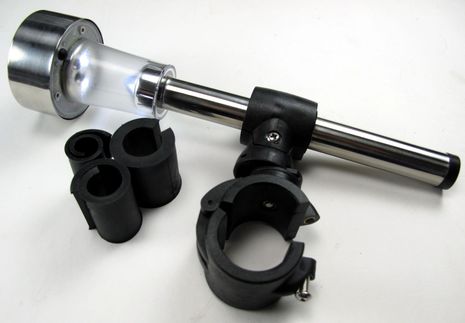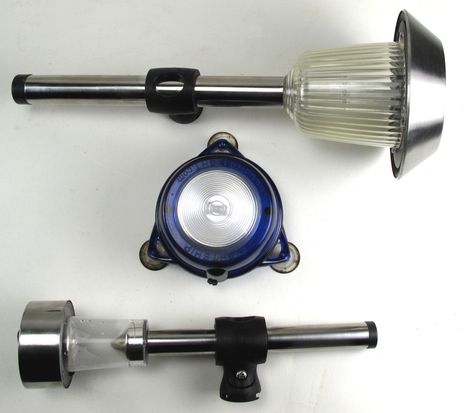RailLight Mini, another winner from SolLight
One good sign: Recently, a friend who’d eaten at a waterfront restaurant called to ask if I knew “that there was a bright white light shining on Gizmo’s flying bridge?” Now, in truth, Gizmo’s float is just a few hundred feet from the deck of that restaurant and the SolLight RailLight Mini isn’t all that bright, but it sure is easy to install and use…
A mini solar panel, a replaceable NiMH battery, twin LEDs, an automatic light sensor switch (along with a waterproof manual one), plus a versatile and detachable rail mount are the winning recipe. And the lightweight stainless and nylon construction look to be long lasting. In fact, test samples of the company’s cute Lightship and shimmering LightCap lantern-in-a-bottle are still working after years of use, and still appreciated. SolLight also offers a Premium RailLight that’s almost twice as bright, includes several more mounting options, and might also serve as a dinghy running light.
At any rate, below is an attempt at illustrating how the Mini illuminates the steps up to Gizmo’s flying bridge. Photos like this are dodgy, but I can tell you that it works, and at about $30 is appealing little cruising accessory. I just wish that installing some serious solar panels on the cabin top aft of those stairs wasn’t a 100 times more complex a project. I will be seeking your advice on the details, and if any of you have had good experience with an online (or Maine-based) solar panel/controller distributor, please let me know in the comments.















But can’t you buy the same light sans the clamp at Walmart for $4.00?
Ben, I have installed several of these controllers and the owners seem to be very happy with them, although we have not use one on our own boat;
http://www.blueskyenergyinc.com/products/details/solar_boost_2512i/
Chuck
Thanks, Chuck, those Blue Sky MPPT controllers are definitely on my short list.
Jim, I have a couple of $4 solar lights from Lowes in my yard…definitely not the same components or build quality.
How does the brightness of the RailLight compare to your Home Depot solar light? Do you think the RailLight is bright enough to use as an anchor light?
I had one of those from WalMart for about 2-4$, and it lasted about 3 seasons until I accidentally stomped on it and snapped off the base. The rest still works fine. They fit perfectly in the sternpost flag-holder for nights and kept the boat on its med-mooring visible when nose-in.
At a cost of about 12$ per decade on average, it isnt bad, but then again it is a foible. If I am buying something that has to last offshore and will be part of the core boat systems, nothing beats a standard aqua-signal light with components available everywhere right down to the bulb sockets.
Mike, the Mini, rated at .3 watt, seems somewhat brighter than the $4 Lowe’s LED. The Premium RailLight model, at .5 watt, might work OK as an anchor light, but the Troll is right that none of these solar powered LEDs is on a par with a real marine nav light.
Then again, this $40 plug-in LED anchor/utility light from Sailor’s Solutions looks like it would be effective:
http://sailorssolutions.com/index.asp?page=ProductDetails&Item=LEDPC01
I have a traditional anchor light at the masthead, but 80′ off the water it isn’t much use in crowded anchorages where I’d like to attract the attention of dinghies and late arriving yachts who’s attention is focused more at water level.
This light could fill a niche there, though some sort of quick release and/or hanging attachment would be better.
I especially like the absence of wires.
Hi Ben,
On our sailboat we have installed 4 solar panels totaling 500 watts, plenty to keep up with our daily needs and then some. We’re also using an Outback MX60 MPPT Controller.
As you know solar panels can be wired in parallel (most common installation) or in series. The benefit of wiring in series is that you can use much smaller electrical wire for the installation. For example on my 500 watt installation if I had wired them in parallel I would have to use a cable large enough to handle about 32 amps at 13 volts for a run of about 16 feet, this would probably mean using either 6 or 8 gauge wire which wouldn’t necessarily be easy to run through my wire-filled arch.
But having them wired in series I would only have to size my wire for about 8 amps (at 72 volts) which means I could use something as small as 14 gauge. I actually used 10 gauge since I had room for that in my arch’s tube. So wiring in series means that I can use smaller wire potentially making the installation easier. It’s also less expensive than larger wire for the budget conscious boater. (from the regulator to the batteries I used 6 gauge)
So now that I have 80 volts on my solar panel wire coming into the boat I had to get it back down so that I could use it with my 12 volt system. This is where the MPPT controllers come in handy, but be aware that they are not all created equal. The Outback MX60 will handle up to 800 watts for a 12 volt system and has a maximum voltage input rating of 140 volts dc. This gives me flexibility for adding onto my system in the future should the need arise. For those that have a dc system of a different voltage the Outback will handle 24, 36 and 48 volt systems as well. Its pricey though.
The Blue Sky MPPT controllers are good to but have some limitations. For example the 3024i will work for 12 and 24 volt systems and has a maximum input rating of 57 volts (same volts in as out) and 30 amps. For me the biggest limiting factor and the reason I didn’t choose the Blue Sky as it will only accept up to 24 volts on the input for a 12 volt system. This would have meant wiring two sets of panels in parallel and then those two sets in series. And I didn’t want to it that way. With my panels all in series should I decide to add another panel into the array it would be quite easy to wire it in series anywhere in the circuit.
Additionally with an MPPT controller that accepts a higher voltage and steps it down to 12 volts one could choose a single panel that is 350 watts, rated at 36 volts. It just depends on ones needs.
Something else to consider is what one expects out of an MPPT controller. All the manufacturers state that an increase in output by 30% is possible (key words ‘up to’), but the amount of increase depends on the ambient temperature. Only the Outback manual is open about these figures. For example in order to achieve a 30% increase in output the ambient temperature needs to be between -5 and -40 degrees (f). If the ambient temperature is between 50 and 77 degrees (f) then one could expect an output increase of about 6%. Down here in the tropics we notice about a 1% increase on sunny days with an average temperature in the high 80s. Where we do see better performance though is on cloudy days, maybe 3%.
And when sizing solar panels to match the needs of the boat its important to note that solar panels are also temperature sensitive and as the temperature of the panels go up the output goes down. For example our Kyrocera 130 watt solar panels are rated for 130 watt output when the panel temperature is 80 degrees (f). But when the temperature of the solar panel reaches 116 degrees (f)the output drops nearly 25% to 87 watts. This is all according to the specifications sticker on the solar panel. This is also our real life experience. With a total of 500 watts of solar panels (rated) our actual maximum output here in the tropics is about 385 watts. Even in northern climates a solar panel sitting in the sun can reach well over 100 degrees.
Just some thoughts when trying to decide on panels and regulators.
Damon
Excellent material, Damon; thanks so much. Good to know that Maine cold is good for something.
Ben,
beware when wiring solar panels in series. One shadowed panel in a string can reduce the output of the whole string by a large amount.
With parallel wiring, shading one panel only affects the output of that particular panel.
Derek
Derek,
Wiring in series, if the connection box has the proper bypass diodes installed (don’t confuse these with blocking diodes), the shading of one panel is not an issue when wired in series.
Our 500 watt solar array, compensated to about 385 watts in the hot tropic climate, outputs 32 amps during it’s peak output. When the wind generator or radar antenna puts a shadow over the corner of one of my panels that output goes down to about 27 or 28 amps, not a huge reduction. If I take a towel and completely cover one of my panels I get about 23 to 24 amps. Kyrocera panels come with bypass diodes already installed if one wants to wire in series. I don’t know about panels from other manufacturers.
Damon
I had a Premium RailLight. The plastic rail mount broke after one season. Don’t mount these lights where people can brush against them. It doesn’t take much to break the mount as the light stick offers a large lever arm.
Thats exactly what I do.
I have 4 80 watt sharp panels wired in series(yes they have blocking diodes)feeding a Xantrex 60amp MPPT controller.
The controller is wired to 2 output breakers so I can select the 24volt bank or the 12volt bank to charge.
works great!
I also feel like supplementing my anchor light with something much closer to ground level. I find that an LED based cockpit light serves the purpose well and both lights up my cockpit and makes it easier to distinguish our boat sailboat from others nearby. That said, if I kept my sailboat at a mooring rather than at a dock, i wouldn’t hesitate to own a product like this that charges itself and operates independent of my boats power systems.
Ben, I have had good luck with Wholesale Solar in California. Their website is http://www.wholesalesolar.com/
a very knowledgeable and acommadating company.
I also made one from a $3. Hardware store light, and a bracket I made from a pipe bracket. Total cost $3.25. But it is not a legal anchor light, so my original anchor light is still there too, I just don’t use it very often. The hdwe store variety is so cheap that I don’t care if it only lasts 6 months. Adding a few more around he rail is a good idea.
LOL, yep – those are the EXACT same lights you can buy at walmart or OSH for $3-4, although you don’t get the rail mounts, but who cares as velcro works just as well. Seriously, would anyone really pay $30 for these? What a crazy markup!
I repeat, Scott, the RailLight is NOT like any of the cheap solar LED lawn lights I’ve seen. Why not give us a link to the “EXACT” same light at $3-4?
I’m fairly adept with the Google myself, and can’t find any solar LED light of truly similar design…dual bulbs, switch, lower reflector,etc.